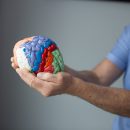Amblyopia (lazy eye)

Amblyopia is cortical blindness. It occurs in approximately 2% of children and it is preventable. It needs to be recognized and addressed prior to 5 years of age. Amblyopia is unilateral defective vision, uncorrectable by lenses. It may occur when two eyes are misaligned, as in strabismus. In this case, the visual information from one eye is suppressed. Fifty percent of children with amblyopia have strabismus. Significantly different refractive errors between the two eyes may also be a cause, as well as occlusion of the visual axis. Risk factors for amblyopia include less than 32 weeks of gestation, family history, worsening astigmatism, strabismus and significant refractive errors between the eyes (Sjöstrand & Abrahamsson 1990, Levartovsky et al 1995, Eibschitz-Tsimhoni et al 2000). Photoscreen photography can be used to screen low-risk children; others should be referred to an ophthalmologist.
Amblyopia can occur in children when there is aberrant or contradictory information coming from a retina. The brain will selectively inhibit development of the cortical cells receiving the aberrant input. Just like cells everywhere else in the nervous system, the cells of the occipital lobe need to be stimulated to function. If the cells are not stimulated, the connections and organization of the cells will be affected. This may occur if a child has a strabismus severe enough that a double image is created. The brain will shut off the signal from the deviant eye. Cells in the occipital cortex receiving signals from this eye will be deprived of stimulation and will not develop. Although the globe, the retina and the nerve pathways may be functional, the occipital lobe cannot interpret the signal they carry. Amblyopia may also occur when the visual acuity in one eye is significantly less than in the other. If undetected, the brain will selectively inhibit the input from the affected eye. There is a critical window of opportunity during which the process of amblyopia can be reversed; many investigators place this time period between 5 and 10 years, although definitive studies are scarce. If the problem is addressed during this time, then the child has a fairly good chance of developing normal function in the involved cortical cells.
Amblyopia is generally treated with occlusion therapy or lenses. Recent studies suggest that visual acuity improves in strabismic amblyopiain the first 6 months of therapy and plateaus thereafter (Cleary 2000). Successful outcome (visual acuity of 20/40) is reduced in the presence of fixed strabismus and worsening astigmatism (Beardsell et al 1999).
Vision and Osteopathy in the Cranial Field
Visual problems are very common in today’s society and take many forms. A good number of these go undiagnosed or untreated, but are amenable to osteopathic treatment.
Functional Eye Problems
involving pressure or tension on nerves controlling the muscles of the eyes, such as strabismus, have responded well to treatment. Certain types phorias and binocularity problems, that is, inability of the eyes to work together properly, respond well also.
Slight pressure on the areas of the brain that coordinate or control the eye muscles can interfere with or scramble the signals causing either the eyes to function improperly or the signals to be interpreted by the brain incorrectly.
There is a particular geometric relationship of the eyes and orbits (bony container around the eye) with respect to the rest of the head. This mechanical relationship must be maintained in order for the eyes to work properly.
Pressure on the nerves involved in the visual pathways can affect the ability to see properly. Some problems require concomitant treatment with an eye doctor and the use of vision therapy.
Visual Strain
History
A number of years ago an osteopathic colleague, Dr. James Jealous, found that some of his patients who were slow to respond to treatment used corrective lenses. On further investigation he discovered that while checking patients’ heads, strains were actually increased or generated in many patients while they were wearing glasses or contact lenses. When these patients were referred to a developmental optometrist and new corrective lenses prescribed, the strains in these patients would noticeably decrease.
One of his students, Dr. Joe Field, took this a step further and spent much time working with this optometrist, Dr. James Mancini, in an attempt to figure out this phenomenon. He worked with the concept that most patients’ glasses altered the patterns that an osteopath could sense in the patient’s body, sometimes to a profound degree. After much study he found that, starting at the point of refraction for correct central vision, he could fit patients with lenses. When this was done correctly, it reduced the strains on the head (and thus the whole body) and many patients with difficult to treat problems improved.
Another colleague, Dr. Paul Dart, studied with Dr. Fields and took this one step further, simplifying the approach and using a system that was easier to understand and reproduce. In addition he added many aspects of dealing with binocular vision problems and proper use of prismatic correction. Since there was much interest, Dr. Dart began to show his colleagues this approach and is constantly working to refine it. He coined the term “visual somatic dysfunction” which describes the structural problems produced in the body through compensation in the eyes.
Eye Anatomy
This whole phenomenon can be easily understood by looking at the anatomy of the eye. The retina, in the back of the eye, is sensitive to incoming light focused on it by the lens and cornea. The retina has many cells in it that respond to light.
The most highly concentrated area of these cells in the middle of the retina is called the fovea. The fovea is the area that allows us to have highly discriminatory central vision, vision that can distinguish detail to a great degree. Most of the remainder of the retina is referred to as the periphery, and this is the area that allows us to have peripheral vision. Incoming light is focused on the whole retina including the fovea and this forms an image, which is then transmitted to the brain and discerned as a visual image.
The eye is filled with a gelatinous, light transmitting substance with orderly rows of protein molecules that give it slight “contractile” properties. We believe this allows the eye to somewhat change shape in response to the proper stimulus. The shape of the eye is also subject to tension in the connective tissue surrounding it to some degree.
The fovea is in a depression almost 1/2 a millimeter behind the surface of the retina so it has a different plane of focus than the rest of the eye. That is, when an object is in focus on the periphery, it is not in perfect focus on the fovea and visa versa. To get the very best visual acuity possible, the light can be made to focus on the fovea as opposed to the rest of the retina. Glasses are usually fit to enhance visual acuity to its maximum amount.
Production of Visual Strain
The problem occurs due to the fact that the body prefers the image to be in focus on the periphery, not the fovea. In other words, it appears that evolution has favored peripheral vision over central vision, as this may have been a survival mechanism. When the image is focused centrally, the eye tries to compensate for this, producing a physical strain as it attempts to slightly change its configuration such that light will be focused more on the periphery. This can be felt by anyone with the proper training.
Exam for Visual Somatic Dysfunction
The procedure to do this is very simple, but balancing the strain with corrective lenses can sometimes be time consuming.
To screen a patient the physician usually monitors the head of the patient according to standard procedure in OCF. This is done with no light entering the eyes and carefully compared to the findings with light entering the eye. This can be done with the patient looking at a distance and then closely, with the patient reading printed material. This screening exam allows us to determine if visual somatic dysfunction is present.
Treatment of Visual Strains
The physician usually inquires about a recent refraction. The patient may be referred to an eye doctor for an eye exam if this not recent. In addition, the eye doctor can uncover any unusual problems. The refraction is the starting point in determining treatment.
Balancing the strain
The osteopathic prescription to treat a visual strain should be close to the refraction, but is rarely the same.
The physician checks the physical strain patterns by monitoring the motion in the patient’s head while fitting different lenses over the eyes, comparing what he finds with the eyes closed and as opposed to being open. If there is no change between the two, no strain is produced by light entering the eyes; this is a balanced prescription. If a strain is produced when the eyes are open (by the eye compensating when light enters it), then a problem still exists and the prescription needs to be adjusted accordingly. Keep in mind that this is a stepwise process repeated with different types and combinations of lenses.
Effects of Treatment
Remember, the proper prescription will produce the least effect on the body’s normal motion and will add no new strain patterns with light coming through the eyes. As the body is one continuous unit, this balanced prescription will not only reduce the physical strain on the head, but also on the neck, shoulders, back and in fact, the whole body. Reducing the stress load on the body increases the level of health and thus, the ability of the body to help itself. Along with osteopathic treatment, this will help resolve chronic strains in the body, which contribute to health problems.
Since the use of corrective lenses is aimed at optimally reducing the strain on the body, as compared with increasing visual acuity, the prescription needs to be checked every 1-2 months and adjusted accordingly over time as the body balances itself out. Some patients can progress to the point where no correction is needed to balance the body.
As the strength of the prescription is usually being reduced over time, this can have the side effect of increasing the ability to see clearly without glasses.
Occasionally nearsighted individuals may notice that their distance vision (acuity) is not quite as good with a balanced prescription as with a traditional prescription, though it should still be acceptable. Very rarely a patient will notice that their visual acuity is significantly different with a balanced prescription. This is usually a temporary condition and tends to decrease with time. These patients, as in most, should notice a difference in their other problems, such as a decrease in headaches or musculoskeletal pain.
In conditions such as mild dysphorias and amblyopia, prism correction may be required. An eye doctor is consulted before working with this type of problem, as there may be certain cautions or difficulties if central suppression is present.














